The setting sun dyes the sky a soft orange as Link glides through the air. Far beneath his dangling feet, Hyrule lies almost forgotten as my focus is fully set on the collection of islands scattered across the horizon. One in particular catches my eye – a small island adorned with a tower, which seems to hail from a lost civilization, and, lying at its feet, a pool of water. Carefully I manoeuvre Link above this pool and, when the time is right, send him diving down to the floating isle. Somehow, even high in the heavens, fish swim in the water.
Tears of the Kingdom is unique in the Zelda series in that it’s the first time a new instalment has reused a Hyrule from a previous game rather than completely reinventing the country. Outside of the game’s trailers and a Bokoblin infested fort I invaded during a recent preview event at Nintendo’s European headquarters in Germany, we don’t know how much the Hyrule overworld has changed since Breath of the Wild. Yet, from what I’ve experienced, the sky islands help prevent this returned trip to a familiar Hyrule from feeling repetitive by bringing a new landscape to a world many of us have spent months exploring.
Some of the islands are landmasses, with cave networks and summits that reach a height where Link will need warm clothing or a trusty torch to survive. Others are smaller – possibly containing a puzzle or, in some cases, being a puzzle themselves. Nearly every island you visit, however, has remnants of a forgotten race whose architecture resembles the Zonai ruins from Breath of The Wild. How involved the Zonai are with the events of Tears of the Kingdom is yet to be seen – I’m sorry to say I know as much about the game’s storyline as you do. Their memory is alive though in the form of the talkative Zonai mining robots and far less friendly Zonai constructs.
The sky islands have also been designed in a way which allows you to travel easily between them, be it by offering you the opportunity to create an updraft for Link’s paraglider or by containing devices, like fans, which can be used to move the floating metal boxes or build custom flying machines. Many islands sit at different heights too, so you could be soaring through the sky completely unaware of the landmass passing beneath you. This not only brings a sense of depth to the sky, but promises to reward backtracking for, like the first time a Lynel nearly crushed you beneath its hoof in Breath of the Wild, there are challenges in the sky which require Link to become more powerful before he can overcome them.
Thankfully your airborne journeys are eased by the return of the Travel Medallion, which is perfect for traversing the sky. Place it on an island and it allows you to quickly return there whether it’s due to a fall to Hyrule below or a wrong turn. If you do fall after forgetting to place the medallion, there are other ways to return to the sky – though we can’t go into details – so don’t worry about having to return to one specific location.
The design of the sky islands also implements Link’s new abilities both for transportation and the puzzles you can solve. My favourite puzzle from the preview event involved using Ultrahand. Ultrahand grants Link the ability to pick up nearly every object you encounter, from explosive barrels to Koroks. During my time in the sky, I came across a set of three islands and, on the first, sat a device which resembled the middle island. Using Ultrahand, I was able to move this device and, in doing so, change the angle of the middle island to whatever degree I wished until I had created a pathway between the three. A spark of delight ran through me when I discovered this puzzle; not just because I had something interesting to solve, but because its existence suggests there are more puzzles interwoven into the landscape of Hyrule and its sky awaiting me.
As I turned the moveable isle, I noticed a chest hanging by a vine from one of its walkways and then my quest became figuring out what angle the island needed to be at to make the chest reachable. What I love about this puzzle, though, is that it invited a level of player expression which older Zelda games lacked, offering multiple solutions – such as creating a simple path or utilising Link’s climbing abilities – rather than a set answer.
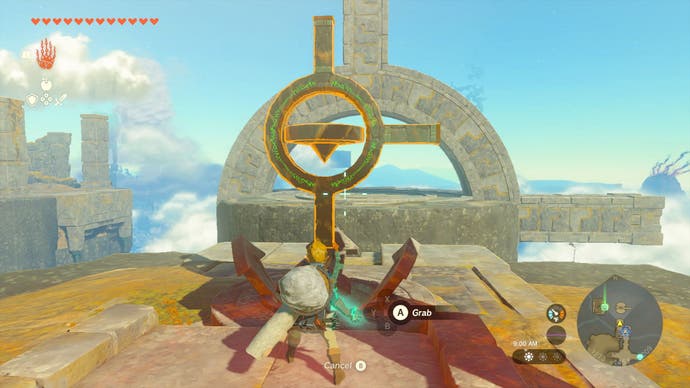
Alongside Ultrahand, I got to experience three of Link’s other abilities. Ascend is a useful power both in and out of combat; granting you the chance to sneak up on enemies and avoid any unnecessary climbing. Thankfully, if you do ascend into a situation you’re not ready to handle, like a sudden drop in temperature or an axe being swung at Link’s head, you can quickly descend back to your original location. Recall, meanwhile, gives you power over the flow of time – turning the clock back on enemies and objects alike. While I wasn’t able to experiment with Recall as much as I’d like, it has the potential to grant you control over the battlefield once mastered and could, hopefully, be involved in some very interesting puzzles. At the time of writing, we have no idea whether Link’s Breath of the Wild abilities will be returning, but, even if they don’t, Link’s new powers will easily keep you occupied, especially the standout, Fuse.

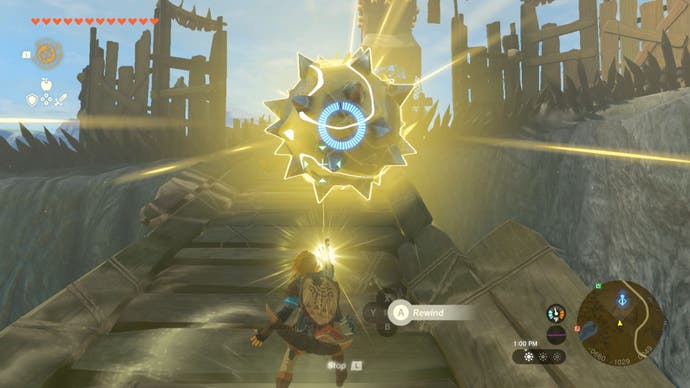
Fuse has two main purposes – fusing objects to weapons and crafting vehicles – and the amount of scope you’ve given is great. It’s hard to avoid getting lost in the excitement of fusing random objects to weapons simply to see what they will do, especially since, in my experience, nearly every object is fusible. Some, like rocks, simply increase a weapon’s attack power, while others will grant the weapons a new ability. Fusing a topaz to a sword, for example, allows it to shoot bolts of electricity. Arrows can also have a range of items easily fused to them before you shoot. I enjoyed fusing ChuChu jellies to arrows since, depending on the colour, they grant an elemental ability, such as White ChuChu jelly arrows freezing enemies. Apples, meanwhile, are far less effective unless your foe has scurvy.
Fusing also increases a weapon’s durability, which is incredibly useful when you find a weapon you’d like to keep around for a while. Yet, it’s important to remember you can only fuse one object to a weapon or a shield at one time. Thankfully, the controls for fusing both weapons and arrows are quick to master allowing you to use the ability with ease in combat. That said, if you fuse an explosive barrel to a sword, I would recommend throwing your new weapon rather than swinging it or else you might find yourself caught in a rather fiery reaction…
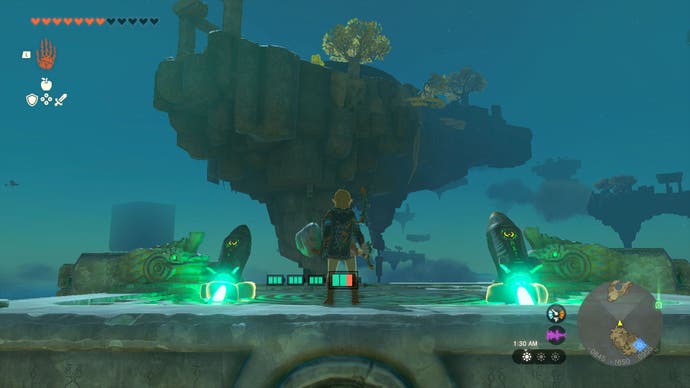
A new collection of items called Zonai devices are vital to the Fuse ability. These gadgets range from fans and portable stoves to rockets and flamethrowers. You can find Zonai devices through a variety of means, but the most notable is from what can only be described as a fanstical gacha machine. Pop some Zonai Charges in and, in true gacha tradition, pray you’ll get what you’re looking for in return. Zonai devices can, of course, be fused to weapons and shields. My personal favourites are how fusing a rocket to a shield turns it into a jetpack and, if you choose to fuse a flamethrower instead, it transforms your flimsy wooden shield into, well, a flamethrower. The main use for many of the Zonai devices, however, is creating vehicles.

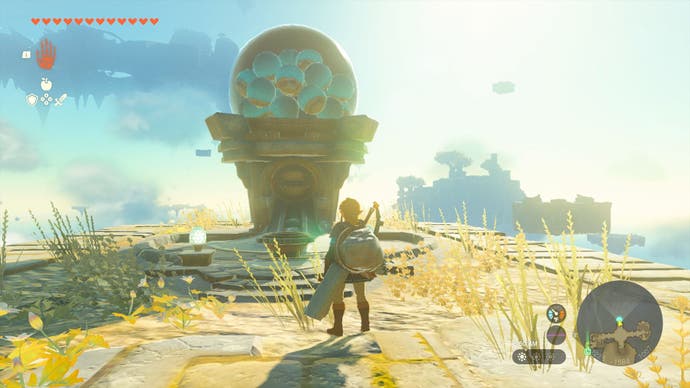
Using Fuse to build vehicles works in tandem with Ultrahand, which you’ll use to position and choose the angle of the device you’re fusing to the basis of your new mode of transportation – be it a log or a bird-like glider. It’s important to ensure your device is placed correctly, because, if a fan or rocket is angled incorrectly, you’ll find yourself going further away from your destination instead of towards it. Not to mention ensuring all of the devices are evenly placed so your creation won’t tip over and that it has enough Zonai battery power to sustain your journey. Usefully, detaching a fused Zonai device is very easy to accomplish, so, if you do make a mistake, it’s quick to fix. Though I can’t go into specific detail, you will eventually gain an ability designed to streamline building, which is ideal for when you don’t want vehicle construction to distract you from your current goal.
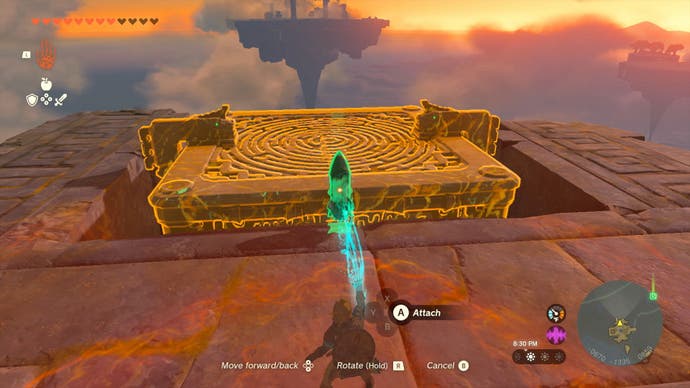
Tears of the Kingdom wants to fill players with a passion for creativity and experimentation in the same way Breath of the Wild urged for exploration. I can easily see myself spending hours constructing the perfect death machine, which will crush enemies without me ever having to unsheathe a sword. Even after building a glider with multiple rockets and flamethrowers, it feels like I’ve barely seen what the Fuse ability has to offer and I’m looking forward to discovering what it can do outside of the realms of combat and transportation. I’ve already fused a Korok to a minecart – what else can it do?
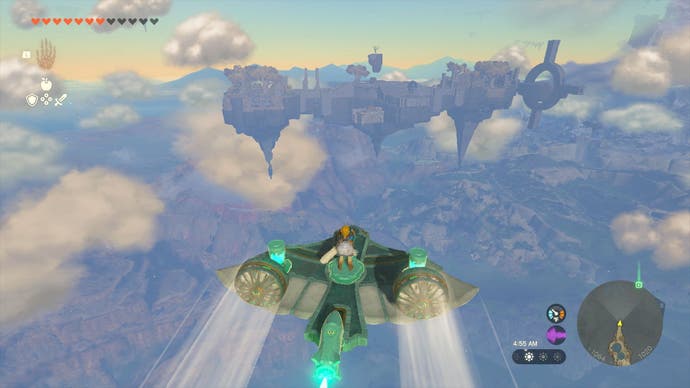
Despite being a direct sequel to Breath of the Wild, Tears of the Kingdom feels more akin to a Majora’s Mask spiritual successor. Not in the terms of cow-stealing aliens, toilet ghosts and imminent death by moon, but in how Majora’s Mask transformed the formula the previous title excelled at into a wonderfully unique journey without ever losing what players originally fell in love with. From what I’ve experienced, Tears of the Kingdom embraces creativity, giving players the opportunity to indulge in their imagination, without sacrificing the adventurous heart of its predecessor. Much of the game still remains a mystery – we’re yet to see a dungeon nor know what on Hyrule Zelda is up to – but we do know it will be a heroic venture and one Link can undertake in his underwear.
